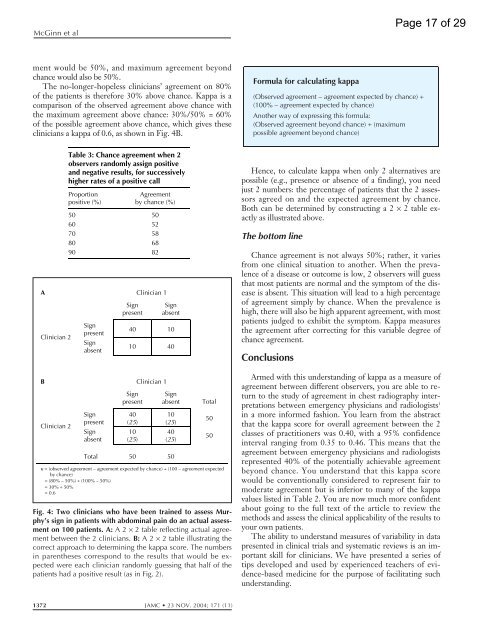Tips for Learners of Evidence-Based Medicine
Tips for Learners of Evidence-Based Medicine
Tips for Learners of Evidence-Based Medicine
You also want an ePaper? Increase the reach of your titles
YUMPU automatically turns print PDFs into web optimized ePapers that Google loves.
McGinn et al<br />
ment would be 50%, and maximum agreement beyond<br />
chance would also be 50%.<br />
The no-longer-hopeless clinicians’ agreement on 80%<br />
<strong>of</strong> the patients is there<strong>for</strong>e 30% above chance. Kappa is a<br />
comparison <strong>of</strong> the observed agreement above chance with<br />
the maximum agreement above chance: 30%/50% = 60%<br />
<strong>of</strong> the possible agreement above chance, which gives these<br />
clinicians a kappa <strong>of</strong> 0.6, as shown in Fig. 4B.<br />
A Clinician 1<br />
Clinician 2<br />
Sign<br />
present<br />
Sign<br />
absent<br />
Sign<br />
present<br />
Sign<br />
absent<br />
40 10<br />
10 40<br />
B Clinician 1<br />
Clinician 2<br />
Table 3: Chance agreement when 2<br />
observers randomly assign positive<br />
and negative results, <strong>for</strong> successively<br />
higher rates <strong>of</strong> a positive call<br />
Proportion<br />
positive (%)<br />
Sign<br />
present<br />
Sign<br />
absent<br />
Sign<br />
present<br />
40<br />
(25)<br />
10<br />
(25)<br />
Agreement<br />
by chance (%)<br />
50 50<br />
60 52<br />
70 58<br />
80 68<br />
90 82<br />
Sign<br />
absent Total<br />
10<br />
(25)<br />
40<br />
(25)<br />
Total 50 50<br />
κ = (observed agreement – agreement expected by chance) ÷ (100 – agreement expected<br />
by chance)<br />
= (80% – 50%) ÷ (100% – 50%)<br />
= 30% ÷ 50%<br />
= 0.6<br />
Fig. 4: Two clinicians who have been trained to assess Murphy’s<br />
sign in patients with abdominal pain do an actual assessment<br />
on 100 patients. A: A 2 × 2 table reflecting actual agreement<br />
between the 2 clinicians. B: A 2 × 2 table illustrating the<br />
correct approach to determining the kappa score. The numbers<br />
in parentheses correspond to the results that would be expected<br />
were each clinician randomly guessing that half <strong>of</strong> the<br />
patients had a positive result (as in Fig. 2).<br />
1372 JAMC 23 NOV. 2004; 171 (11)<br />
50<br />
50<br />
Formula <strong>for</strong> calculating kappa<br />
(Observed agreement – agreement expected by chance) ÷<br />
(100% – agreement expected by chance)<br />
Another way <strong>of</strong> expressing this <strong>for</strong>mula:<br />
(Observed agreement beyond chance) ÷ (maximum<br />
possible agreement beyond chance)<br />
Hence, to calculate kappa when only 2 alternatives are<br />
possible (e.g., presence or absence <strong>of</strong> a finding), you need<br />
just 2 numbers: the percentage <strong>of</strong> patients that the 2 assessors<br />
agreed on and the expected agreement by chance.<br />
Both can be determined by constructing a 2 × 2 table exactly<br />
as illustrated above.<br />
The bottom line<br />
Chance agreement is not always 50%; rather, it varies<br />
from one clinical situation to another. When the prevalence<br />
<strong>of</strong> a disease or outcome is low, 2 observers will guess<br />
that most patients are normal and the symptom <strong>of</strong> the disease<br />
is absent. This situation will lead to a high percentage<br />
<strong>of</strong> agreement simply by chance. When the prevalence is<br />
high, there will also be high apparent agreement, with most<br />
patients judged to exhibit the symptom. Kappa measures<br />
the agreement after correcting <strong>for</strong> this variable degree <strong>of</strong><br />
chance agreement.<br />
Conclusions<br />
Page 17 <strong>of</strong> 29<br />
Armed with this understanding <strong>of</strong> kappa as a measure <strong>of</strong><br />
agreement between different observers, you are able to return<br />
to the study <strong>of</strong> agreement in chest radiography interpretations<br />
between emergency physicians and radiologists 1<br />
in a more in<strong>for</strong>med fashion. You learn from the abstract<br />
that the kappa score <strong>for</strong> overall agreement between the 2<br />
classes <strong>of</strong> practitioners was 0.40, with a 95% confidence<br />
interval ranging from 0.35 to 0.46. This means that the<br />
agreement between emergency physicians and radiologists<br />
represented 40% <strong>of</strong> the potentially achievable agreement<br />
beyond chance. You understand that this kappa score<br />
would be conventionally considered to represent fair to<br />
moderate agreement but is inferior to many <strong>of</strong> the kappa<br />
values listed in Table 2. You are now much more confident<br />
about going to the full text <strong>of</strong> the article to review the<br />
methods and assess the clinical applicability <strong>of</strong> the results to<br />
your own patients.<br />
The ability to understand measures <strong>of</strong> variability in data<br />
presented in clinical trials and systematic reviews is an important<br />
skill <strong>for</strong> clinicians. We have presented a series <strong>of</strong><br />
tips developed and used by experienced teachers <strong>of</strong> evidence-based<br />
medicine <strong>for</strong> the purpose <strong>of</strong> facilitating such<br />
understanding.
















